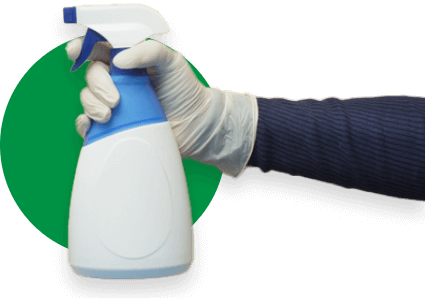As winter’s grip loosens and the days grow longer, a sense of renewal fills the air. The arrival of spring makes it the perfect time to extend that refreshing energy to your office space with a thorough seasonal deep clean. More than just an aesthetic upgrade, a clean workspace significantly boosts productivity, elevates employee morale, and fosters a healthier environment.
Studies have shown that clean and organized offices reduce distractions, improve focus, and even lead to fewer sick days. After months of being cooped up indoors with recirculated air, dust accumulation, and the lingering effects of winter colds, a comprehensive spring clean is precisely what your office needs to revitalize and prepare for a productive season ahead.
While the task might seem daunting, remember that professional janitorial services stand ready to assist.
1. Declutter Your Office Like a Pro
A fresh start begins with clearing out the unnecessary and organizing what remains. A decluttered workspace minimizes distractions and maximizes efficiency.
Desks and Workstations
Begin by tackling individual workspaces. Encourage everyone to toss old paperwork, organize their supplies, and thoroughly clean out desk drawers. Implement a system for managing current documents and discarding those that are no longer needed.
Filing Cabinets & Digital Files
Don’t neglect filing cabinets and digital storage. Shred outdated physical documents securely and organize digital files logically. Establish transparent file naming conventions to improve searchability and streamline workflows. Regularly backing up important digital files is also crucial during this organizational overhaul.
Common Areas
Extend the decluttering effort to shared spaces, such as break rooms, meeting rooms, and reception areas. Remove any unnecessary items and ensure these areas are welcoming and functional.
Consider implementing a “one-year rule” for office clutter. If an item hasn’t been used or referenced in the past year, seriously consider tossing it, donating it, or archiving it!
2. Deep Clean Every Office Surface
Once the clutter is gone, it’s time for a deep clean that eliminates dust, germs, and allergens from every surface.
Desks, Keyboards, and Phones
These high-touch surfaces are breeding grounds for bacteria and germs. Wipe down all workstation surfaces with disinfectant wipes, paying special attention to phones, keyboards, and mice. Use commercial cleaning-grade disinfectants proven effective against common office pathogens.
Monitors and Screens
Dust and streaks on monitors can strain eyes. Gently wipe screens with microfiber cloths specifically designed for electronics. Avoid using harsh chemicals or excessive moisture, as they can damage sensitive equipment. Use screen-safe cleaning solutions.
Chairs and Upholstery
Office chairs and upholstered furniture accumulate dust, allergens, and spills. Vacuum all upholstery thoroughly, paying attention to crevices. For fabric-specific cleaning, consult the care label or consider professional upholstery cleaning to remove allergens.
Windows and Blinds
Clean windows inside and out to maximize natural light and improve the overall atmosphere. Dust blinds or wash them according to their material. Clean windows significantly contribute to improved air quality and a brighter workspace. Use the right window cleaning solutions for streak-free results on various window types.
Checklist:
- Wipe down all workstations
- Disinfect high-touch surfaces (phones, keyboards, and mice)
- Dust shelves, bookcases, and window ledges
- Vacuum or steam clean office upholstered furniture
3. Breathe Easy: Improve Office Air Quality
Improving indoor air quality is a key benefit of office spring cleaning, contributing directly to employee health and productivity.
Replace Air Filters
HVAC systems circulate air throughout the office, and dirty air filters trap dust, allergens, and other pollutants, including bacteria. Replace air filters according to the manufacturer’s recommendations, typically every 1-3 months, or more frequently in high-usage environments. Consider high-efficiency particulate air (HEPA) filters for superior air purification.
Open Windows
Weather permitting, open windows to allow fresh air to circulate and naturally ventilate the office. Even a short period of open windows can significantly improve air quality.
Check for Mold & Musty Smells
Inspect areas prone to moisture buildup, such as bathrooms, kitchens, and near windows, for signs of mold or musty odors. Address any leaks or ventilation issues promptly to prevent potential health risks associated with mold growth.
Clean Air Vents and Ceiling Fans
Dust accumulates on air vents and ceiling fan blades, which hinders airflow and recirculates dust particles. Wipe down air vents and fan blades regularly to improve air circulation and prevent dust from building up.
Consider introducing indoor plants known for their air-purifying qualities, such as snake plants, spider plants, and peace lilies, to improve your office’s air quality naturally.
4. The Office Breakroom and Kitchen Refresh
The breakroom and kitchen are often high-traffic areas that require thorough, deep cleaning during spring.
Refrigerator Clean-Out
Empty the refrigerator and discard any expired or forgotten food. Wipe down all shelves and interior surfaces with a disinfectant cleaner.
Microwave & Coffee Makers
Scrub away built-up grime and food splatters inside and outside the microwave. Descaling coffee makers using a solution of vinegar and water to remove mineral deposits that can affect performance and taste.
Countertops & Cabinets
Clear countertops and wipe down all surfaces. Clean cabinet doors and organize supplies inside for better functionality.
Sink & Faucet Areas
Sanitize the sink and faucet handles to remove bacteria and buildup. Pay attention to grout and areas prone to moisture.
Checklist:
- Clean inside and outside of appliances
- Wipe down tables and chairs
- Sanitize high-touch surfaces (coffee pot, handles, buttons)
5. Commercial Restroom Revival: A Deep Cleaning Must
A clean and well-maintained restroom is essential for employee health and reflects positively on your business.
Sanitize Toilets and Sinks
Use a strong disinfectant cleaner to thoroughly clean and sanitize toilets, including the bowl, seat, and handle. Disinfect sinks and faucets, paying special attention to the areas around the drains.
Check Soap and Paper Supplies
Restock soap dispensers to full and ensure an adequate supply of paper towels and toilet paper.
Scrub Floors and Tile Grout
Clean the restroom floors thoroughly, paying particular attention to the tile grout, where grime and bacteria can accumulate. Use a grout brush and a suitable cleaning solution to remove buildup.
Check for Leaks or Plumbing Issues
Inspect toilets, sinks, and pipes for any signs of leaks or other plumbing problems and address them promptly to prevent water damage and waste.
Establish a regular schedule for deep cleaning the restrooms that goes beyond daily maintenance tasks to ensure a consistently clean and hygienic environment.
6. Office Floor Care: From Commercial Carpets to Hard Surfaces
Floors in a commercial setting endure a lot of wear and tear, making thorough cleaning essential during spring cleaning.
Vacuum and Steam Clean Carpets
Carpets trap dust, allergens, and dirt deep within their fibers. Vacuum all carpeted areas thoroughly. Consider professional commercial cleaning services for a deep clean office carpet, using hot water extraction (also known as steam cleaning) to remove embedded contaminants and refresh the fibers.
Mop and Polish Hard Floors
Sweep or vacuum hard floors to remove loose debris. Then, mop with a floor-specific cleaner to eliminate scuffs, stains, and grime. Consider polishing hard floors to restore their shine and protect the surface.
Wipe Down Baseboards
Baseboards often accumulate dust and dirt. Wipe them down with a damp cloth to complete the clean look.
Clean Entry Mats
Entry mats trap dirt from shoes and prevent it from spreading throughout the office. Shake them out or wash them thoroughly. Replace worn-out mats to maintain cleanliness.
7. Don’t Forget High-Touch Surfaces!
These often-overlooked areas can harbor a significant amount of germs.
Light Switches and Door Handles
Regularly wipe down all light switches and door handles with disinfectant wipes.
Conference Room Equipment
Sanitize shared conference room equipment, including remote controls, whiteboards, and chairs.
Printers, Copiers, and Shared Devices
Wipe down printers, copiers, and other shared electronic devices with cleaning wipes specifically designed for this purpose to keep them germ-free and fingerprint-free.
Consider creating a rotating schedule to sanitize these high-touch areas throughout the year, maintaining a consistently clean and healthy environment.
8. First Impressions: Business Exterior and Curb Appeal
Don’t neglect the exterior of your office during spring cleaning, as it makes a significant impression on clients and visitors.
Windows and Exterior Doors
Wash exterior windows and doors to create a fresh and inviting look.
Sidewalks and Parking Lots
Sweep away debris from sidewalks and parking areas. Power wash if necessary to remove built-up grime and stains.
Outdoor Furniture
If your office has outdoor seating areas, clean and refresh the furniture.
A clean exterior creates a positive first impression on clients and visitors, reflecting your company’s attention to detail.
9. Stock Up the Office and Stay Prepared
Ensure you have the necessary supplies to maintain cleanliness after your spring deep clean.
Check Inventory
Replenish your stock of disinfectant wipes, hand sanitizers, cleaning solutions, paper towels, and other essential cleaning supplies.
Upgrade Cleaning Equipment
Assess the condition of your existing cleaning equipment. Replace old mops, worn-out cloths, and vacuum bags to ensure effective cleaning.
The Professional Touch: Consider Janitorial Services
Hiring a professional janitorial services team offers numerous benefits for your office spring cleaning needs. Their expertise ensures a deeper, more thorough clean than in-house efforts, saving your team valuable time and effort. Professionals possess the right equipment, specialized cleaning solutions, and the knowledge to tackle even the most challenging cleaning tasks efficiently and effectively. Moreover, establishing a routine cleaning schedule with a professional service keeps your office consistently fresh and healthy throughout the year, preventing the buildup of dirt and allergens that can impact productivity and overall well-being. Consider Dallas Janitorial Services as your trusted partner in maintaining a clean and productive workspace.
Reap the Rewards of a Clean Office
Investing in a thorough spring clean of your office yields significant rewards. A clean workspace fosters improved productivity by minimizing distractions and creating a more organized environment. It contributes to a healthier atmosphere by reducing allergens and improving air quality, leading to fewer sick days and increased employee well-being. Ultimately, a sparkling clean office enhances your workplace atmosphere, creating a more positive and professional environment for everyone. Encourage employees to maintain the cleanliness achieved through simple daily habits.
Ready to transform your office into a clean, productive, healthy space? Contact Dallas Janitorial Services today for a free consultation and let us take care of your spring cleaning.
Office Spring Cleaning FAQ
What does a professional spring clean include?
A professional spring clean typically includes a comprehensive dusting of all surfaces, deep cleaning of carpets and hard floors, thorough cleaning and sanitizing of bathrooms and kitchens, window cleaning (both interior and sometimes exterior), cleaning of light fixtures and vents, and often upholstery cleaning. They address overlooked areas and use specialized equipment and solutions for a deep and lasting clean.
How often should an office do a deep clean?
Most offices benefit from a deep clean at least once or twice a year. Spring and fall are standard times to schedule a deep clean to address seasonal buildup of dust, allergens, and general grime. High-traffic offices or those in industries with specific hygiene requirements may need more frequent deep cleaning.
What are the biggest problem areas people forget to clean in an office?
Commonly overlooked areas include light switches and door handles, computer keyboards and mice, under desks and chairs, air vents and ceiling fans, the inside of microwaves and refrigerators, baseboards, and window blinds. Make sure to include these in your cleaning routine.
How can we encourage employees to clean the office after a deep clean?
Encourage employees by providing the necessary cleaning supplies and making it easy for them to tidy their workspaces daily. Implement a rotating schedule for shared cleaning tasks in common areas. Lead by example, and communicate the benefits of a clean workspace for productivity and health. Positive reinforcement and recognition can also motivate participation.
What’s the best way to remove office carpet stains and odors?
The best way to remove office carpet stains and odors involves professional hot water extraction, also known as steam cleaning, with specialized stain removal treatments. For immediate spills, blot the area gently and use a carpet-specific cleaner. Professional services have the expertise and equipment to tackle deep-seated stains and neutralize odors effectively without damaging the carpet.
How do professional office cleaning services compare to in-house cleaning?
Professional office cleaning services offer a more thorough and consistent clean due to specialized equipment, trained staff, and industry-grade cleaning solutions. They can handle deep cleaning tasks efficiently, saving in-house staff time and ensuring a higher standard of hygiene and appearance, ultimately contributing to a healthier and more productive workspace.







